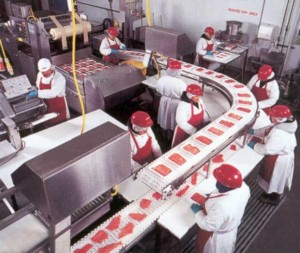The supply chain is a dynamic thing. Supplier capabilities and prices change. Currency exchange rates fluctuate daily. Commodities have been particularly volatile recently. Transportation costs vary with the price of oil and are affected by geopolitical events. Weather, earthquakes, floods, fires, piracy… lots of things can affect availability, cause price swings, and disrupt the smooth flow of goods from one place to another.
The supply chain is set up to support company operations and goals, according to the prevailing conditions at the time. When those conditions change, the supply chain must be ready and able to change accordingly. And the more elements in the chain (the further it is from supplier to buyer, the more transportation links involved) the higher the risk of change or disruption.
Many companies establish long supply chains to take advantage of favorable pricing from low-wage area suppliers. This is a sound approach, as long as all the other related costs are included in the analysis. In addition to transportation, customs, duties, and service fees (agents, consolidators, brokers), be sure to include consideration for the extra inventory you’ll need because of the longer lead time and a factor for obsolescence risk and reduced agility.
Another consideration that many companies ignore, however, is risk. While there is risk associated with any supplier and supply chain, risk of disruption increases with the length of the chain. In order to assess risk, it is necessary to imagine the worst case scenarios. What would be the impact if “x” happened? How would that affect operations? What are the alternatives? What are the costs of those alternatives? Many companies do some level of succession planning for their managers and executives. This is a similar discipline.
While risk assessment will provide additional insight in to the true cost of a supply decision, it also offers an opportunity to develop recovery plans. Then, if the problem does occur, you will be prepared to act immediately – you will already know what to do to keep the plant in operation and keep products flowing.
Sometimes, however, there is no practical alternative. In this situation, it is helpful to consider the cost of shutting down the plant for however long it takes to get the supply back on-line. The cost may well be high enough to justify development of another alternative (another supplier, substitute material or part, different transportation modes or providers), the existence of which could well change the original risk/justification equation.
As you can see, even risk and recovery planning is dynamic. Supply chain planning goes beyond just setting things up the first time. Risk must be included in the plan and every part of the supply chain should be continually monitored to detect any changes in the assumptions that went into the current plan. Then, consider the “what if” possibilities, factor risk and impact into cost justification, and prepare recovery alternatives ahead of the need.





 I am very pleased to be CEO of Plex Systems. I have always been focused on how technology can add value to businesses. At Plex we live that mantra every day. We never develop software for technology's sake. I started my career with Arthur Andersen (the part that is now Accenture) in Boston. I have led and been part of business technology companies my entire career with a focus on manufacturers and distributors in various vertical industries. I've always loved the fast pace of innovation in the technology business and I am thrilled to be part of a discontinuous disruption.
I am very pleased to be CEO of Plex Systems. I have always been focused on how technology can add value to businesses. At Plex we live that mantra every day. We never develop software for technology's sake. I started my career with Arthur Andersen (the part that is now Accenture) in Boston. I have led and been part of business technology companies my entire career with a focus on manufacturers and distributors in various vertical industries. I've always loved the fast pace of innovation in the technology business and I am thrilled to be part of a discontinuous disruption.